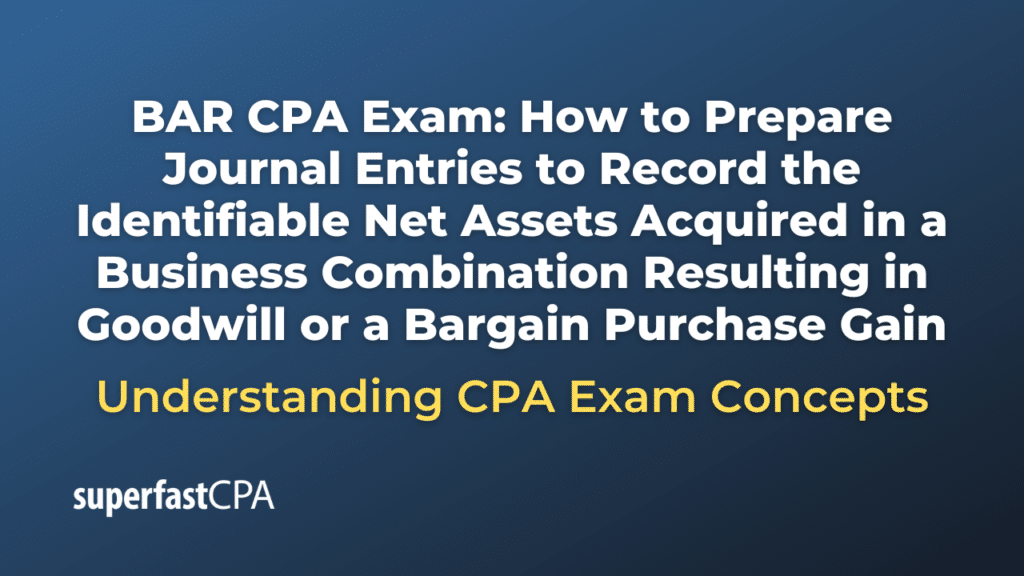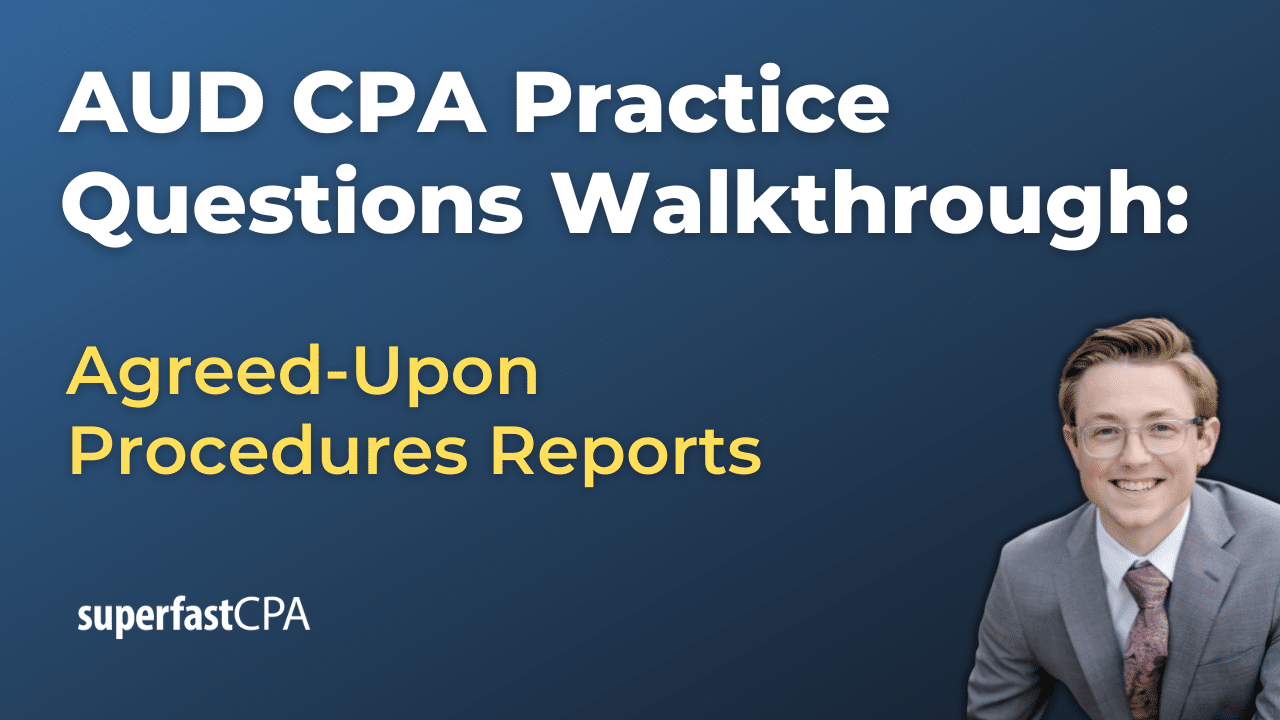Introduction
Overview of Business Combinations and the Importance of Accurate Accounting
In this article, we’ll cover how to prepare journal entries to record the identifiable net assets acquired in a business combination resulting in goodwill or a bargain purchase gain. In the dynamic world of corporate finance, business combinations are a common occurrence, enabling companies to achieve growth, diversify their portfolios, and gain competitive advantages. A business combination involves the merging or acquisition of one company by another, resulting in the consolidation of financial statements and the integration of operations.
Accurate accounting in business combinations is crucial because it directly impacts the financial statements of the acquiring company. The process of recording the assets acquired, liabilities assumed, and any resultant Goodwill or Bargain Purchase Gain must adhere strictly to accounting standards to provide a true and fair view of the financial position. Missteps in accounting for these transactions can lead to significant financial misstatements, which might result in regulatory scrutiny or loss of investor confidence.
Explanation of Key Terms: Identifiable Net Assets, Goodwill, and Bargain Purchase Gain
Before diving into the journal entries involved in a business combination, it is essential to understand the key terms that play a pivotal role in the accounting process:
- Identifiable Net Assets: These are the assets and liabilities of the acquired entity that can be individually recognized and measured at their fair value on the acquisition date. Identifiable assets might include tangible items like property, plant, and equipment, as well as intangible assets such as patents, trademarks, and customer relationships. Liabilities could include accounts payable, debt obligations, or any contingent liabilities.
- Goodwill: Goodwill arises in a business combination when the purchase price paid by the acquiring company exceeds the fair value of the identifiable net assets acquired. This excess is recognized as Goodwill on the balance sheet, representing the future economic benefits from assets that are not individually identified and separately recognized.
- Bargain Purchase Gain: Conversely, a Bargain Purchase Gain occurs when the purchase price paid is less than the fair value of the identifiable net assets acquired. This situation might arise in distressed sales where the seller is motivated to dispose of the assets quickly. The gain is recognized in the acquiring company’s income statement.
Purpose of the Article
The purpose of this article is to provide a detailed guide for preparing journal entries to record the identifiable net assets acquired in a business combination, resulting in either Goodwill or a Bargain Purchase Gain. This guide is tailored for those studying for the BAR CPA exam, ensuring a clear understanding of how to approach these complex accounting transactions.
By the end of this article, readers will have a solid grasp of the steps involved in calculating and recording the fair value of identifiable net assets, how to account for the resulting Goodwill or Bargain Purchase Gain, and the subsequent implications on financial reporting. This knowledge is critical not only for passing the BAR CPA exam but also for ensuring accuracy in professional practice.
Understanding Business Combinations
Definition and Types of Business Combinations
A business combination is a transaction or event in which an acquirer gains control over one or more businesses. These combinations can take several forms, each with its unique characteristics and accounting implications. The most common types of business combinations include:
- Mergers: In a merger, two or more companies combine to form a new entity. The original companies cease to exist, and their assets and liabilities are merged into the new entity. Mergers can be horizontal (between companies in the same industry), vertical (between companies at different stages of production), or conglomerate (between companies in unrelated businesses).
- Acquisitions: An acquisition occurs when one company (the acquirer) purchases another company (the acquiree). The acquirer gains control of the acquiree’s assets and liabilities, which are then consolidated into the acquirer’s financial statements. Unlike a merger, in an acquisition, the acquired company may continue to operate as a separate legal entity under the ownership of the acquirer.
- Statutory Consolidations: In this type of business combination, two or more companies combine to form a new entity, and the original companies are dissolved. The new entity assumes control over all the assets and liabilities of the combining companies.
- Stock Acquisitions: This occurs when the acquirer purchases a majority or controlling interest in the voting shares of another company, thereby gaining control. The acquired company remains a separate legal entity, but its financial results are consolidated with the acquirer’s.
- Asset Acquisitions: Instead of acquiring shares, the acquirer purchases specific assets and liabilities of the target company. The acquired assets are recorded on the acquirer’s balance sheet, and the target company may continue to operate or dissolve, depending on the transaction structure.
Understanding the type of business combination is crucial because it determines the accounting treatment and the structure of the journal entries to be prepared.
Overview of Accounting Standards Governing Business Combinations (e.g., ASC 805)
The accounting for business combinations is primarily governed by Accounting Standards Codification (ASC) 805: Business Combinations, issued by the Financial Accounting Standards Board (FASB). ASC 805 provides the framework for accounting for and reporting business combinations in the financial statements of the acquiring company.
Key principles under ASC 805 include:
- Acquisition Method: ASC 805 mandates the use of the acquisition method for all business combinations. This method requires the acquirer to measure the acquired assets and liabilities at their fair values on the acquisition date. The difference between the purchase consideration and the fair value of net identifiable assets results in either Goodwill or a Bargain Purchase Gain.
- Identifiable Assets and Liabilities: The standard requires that only assets and liabilities that meet the criteria for recognition (i.e., they are identifiable and reliably measurable) be recognized in the acquirer’s financial statements. This includes both tangible and intangible assets.
- Goodwill and Bargain Purchase Gain: If the acquisition cost exceeds the fair value of net identifiable assets, the excess is recognized as Goodwill. Conversely, if the fair value of net assets exceeds the acquisition cost, the difference is recognized as a Bargain Purchase Gain, which is recorded as income in the acquirer’s financial statements.
- Contingent Consideration: ASC 805 also addresses the treatment of contingent consideration, which is additional payment the acquirer may be required to make based on future events or performance of the acquiree. Contingent consideration is initially recognized at fair value on the acquisition date and subsequently remeasured, with adjustments recognized in earnings.
- Disclosure Requirements: ASC 805 requires extensive disclosures to provide users of financial statements with information about the nature and financial effects of business combinations. This includes details on the acquisition date, the fair value of consideration transferred, the amounts recognized for assets acquired and liabilities assumed, and any Goodwill or Bargain Purchase Gain recognized.
Understanding ASC 805 is fundamental for anyone involved in the accounting for business combinations, as it ensures that transactions are recorded accurately and consistently, providing transparency and comparability in financial reporting.
Identifying Net Assets Acquired
Explanation of Identifiable Net Assets in a Business Combination
In a business combination, identifiable net assets refer to the specific assets and liabilities of the acquired company that can be separately recognized and measured. These assets and liabilities are distinguished from the general goodwill that may arise during the acquisition process. Identifiable net assets include both tangible and intangible assets, as well as liabilities that meet certain criteria for recognition.
The process of identifying these net assets is crucial because it forms the basis for allocating the purchase price and determining whether any goodwill or a bargain purchase gain will arise. Proper identification and valuation of these assets and liabilities ensure that the financial statements of the acquiring company accurately reflect the economic reality of the business combination.
Criteria for Recognition and Measurement of Assets and Liabilities
To be recognized as identifiable net assets in a business combination, assets and liabilities must meet specific criteria:
- Existence on the Acquisition Date: The asset or liability must exist at the date of acquisition. This means that the asset should have been acquired, or the liability assumed, by the acquirer as part of the business combination.
- Reliability of Measurement: The asset or liability must be measurable with sufficient reliability. This typically requires the availability of market data or other reliable methods for estimating the fair value of the item.
- Separable or Arising from Contractual or Legal Rights: An intangible asset, for instance, must either be separable from the acquired entity (i.e., it can be sold, transferred, licensed, rented, or exchanged) or it must arise from contractual or other legal rights, regardless of whether those rights are separable.
- Fair Value Measurement: ASC 805 requires that all identifiable assets acquired and liabilities assumed be measured at their fair value on the acquisition date. Fair value represents the price that would be received to sell an asset or paid to transfer a liability in an orderly transaction between market participants at the measurement date.
Examples of Identifiable Assets and Liabilities
Understanding the types of assets and liabilities that can be recognized as identifiable net assets is essential for accurately accounting for a business combination. Here are some common examples:
Identifiable Assets:
- Tangible Assets:
- Property, Plant, and Equipment (PPE): This includes physical assets like buildings, machinery, and vehicles that the acquiring company can use to generate future economic benefits.
- Inventory: Goods held for sale, raw materials, and work-in-progress that can be sold or used in the production process.
- Intangible Assets:
- Patents and Trademarks: Legal rights to use specific inventions or brands that can generate future economic benefits.
- Customer Relationships: Established relationships with customers that are expected to provide future revenue streams.
- Software: Proprietary software or technology that has been developed or acquired by the target company.
- Financial Assets:
- Accounts Receivable: Money owed to the acquired company by its customers for goods or services provided.
- Investments: Ownership interests in other companies or financial instruments that can be converted to cash or generate future returns.
Identifiable Liabilities:
- Accounts Payable: Obligations to pay for goods or services received from suppliers.
- Debt Obligations: Loans, bonds, or other forms of borrowing that the acquired company is responsible for repaying.
- Contingent Liabilities: Potential obligations that may arise depending on the outcome of a future event, such as pending lawsuits or warranties.
- Deferred Tax Liabilities: Taxes payable in the future due to temporary differences between the book value of assets or liabilities and their tax bases.
- Employee Benefit Obligations: Liabilities related to employee benefits, such as pensions or post-retirement healthcare plans.
These examples illustrate the wide range of assets and liabilities that must be carefully identified, measured, and recorded during a business combination. Accurately capturing these items is essential for the preparation of compliant financial statements and for determining the impact of the acquisition on the acquiring company’s financial position.
Calculating the Purchase Price Allocation
Steps to Determine the Fair Value of the Acquired Business
The first step in accounting for a business combination is to determine the fair value of the acquired business. Fair value is defined as the price that would be received to sell an asset or paid to transfer a liability in an orderly transaction between market participants at the measurement date. Accurately determining this fair value is crucial for the subsequent allocation of the purchase price. Here are the key steps involved:
- Engage in Due Diligence: The acquiring company must conduct a thorough due diligence process to gather all relevant financial information about the target company. This includes analyzing financial statements, reviewing contracts, and assessing the market conditions affecting the target’s assets and liabilities.
- Identify Market Comparables: To estimate fair value, the acquirer may look at similar transactions in the market, known as comparables. By analyzing the sale prices of similar companies or assets, the acquirer can estimate what the market is willing to pay for the target’s assets.
- Use Valuation Techniques: Several valuation methods can be used to estimate the fair value of the acquired business:
- Income Approach: This method involves discounting future cash flows generated by the business or specific assets to their present value.
- Market Approach: This approach looks at prices paid for comparable businesses or assets in the market to estimate value.
- Cost Approach: This method assesses the cost to replace or reproduce the acquired assets, adjusted for depreciation and obsolescence.
- Determine the Purchase Price: The final purchase price is typically the result of negotiations between the buyer and seller. This price should reflect the fair value of the business based on the information gathered during due diligence and valuation.
Allocation of the Purchase Price to Identifiable Net Assets
Once the fair value of the acquired business is determined, the next step is to allocate the purchase price to the identifiable net assets acquired. The allocation process ensures that each asset and liability is recorded at its fair value on the acquisition date. Here’s how the allocation process works:
- Identify the Fair Value of Each Identifiable Asset and Liability: The acquirer must determine the fair value of each identifiable asset acquired and liability assumed as of the acquisition date. This includes both tangible and intangible assets, as well as any contingent liabilities.
- Allocate the Purchase Price: The total purchase price is allocated to the fair value of the identifiable net assets in the following order:
- First, allocate to any identifiable intangible assets that meet the criteria for separate recognition (e.g., patents, customer relationships, trademarks).
- Next, allocate to tangible assets such as property, plant, equipment, and inventory.
- Finally, allocate to any liabilities assumed, ensuring that each liability is recorded at its fair value.
- Consideration of Non-Controlling Interests: If the acquirer does not acquire 100% of the target, the fair value of non-controlling interests must be determined and recorded separately in the equity section of the balance sheet.
Explanation of How to Calculate the Excess Amount Leading to Goodwill or a Bargain Purchase Gain
After allocating the purchase price to the identifiable net assets, the acquirer must determine if there is an excess amount. This excess could either result in Goodwill or a Bargain Purchase Gain, depending on whether the purchase price exceeds or falls short of the fair value of the net assets acquired.
- Calculation of Goodwill:
- Formula:
Goodwill = Purchase Price – Fair Value of Net Identifiable Assets - When Goodwill Arises: If the purchase price exceeds the fair value of the identifiable net assets, the excess amount is recognized as Goodwill. Goodwill represents the future economic benefits arising from assets that are not individually identified and separately recognized, such as synergies, customer loyalty, or brand reputation.
- Example: Suppose the purchase price is $10 million, and the fair value of the identifiable net assets is $8 million. The excess of $2 million ($10 million – $8 million) is recognized as Goodwill.
- Formula:
- Calculation of a Bargain Purchase Gain:
- Formula:
Bargain Purchase Gain = Fair Value of Net Identifiable Assets – Purchase Price - When a Bargain Purchase Gain Arises: If the fair value of the identifiable net assets exceeds the purchase price, the difference is recognized as a Bargain Purchase Gain. This typically occurs in situations where the seller is under distress or when assets are purchased at a discount.
- Example: Suppose the purchase price is $5 million, and the fair value of the identifiable net assets is $6 million. The excess of $1 million ($6 million – $5 million) is recognized as a Bargain Purchase Gain, which is recorded as income on the acquirer’s income statement.
- Formula:
This calculation of Goodwill or a Bargain Purchase Gain is a critical step in ensuring that the financial statements accurately reflect the economic substance of the business combination. Properly recording these amounts not only ensures compliance with accounting standards but also provides valuable insights into the value generated (or preserved) through the acquisition.
Journal Entries for Business Combinations
General Structure and Rules for Preparing Journal Entries
When accounting for a business combination, the preparation of journal entries is a critical task that ensures the transaction is accurately reflected in the financial statements. The general structure of these journal entries involves debiting the identifiable assets acquired and crediting the liabilities assumed, with any difference being allocated to either Goodwill or a Bargain Purchase Gain.
Here are some key rules to follow when preparing journal entries for business combinations:
- Recognition at Fair Value: All identifiable assets and liabilities should be recognized at their fair values as of the acquisition date, as per ASC 805.
- Debiting and Crediting: Assets acquired are typically debited (indicating an increase in assets), while liabilities assumed are credited (indicating an increase in liabilities).
- Goodwill or Bargain Purchase Gain: If the purchase price exceeds the fair value of net assets acquired, the difference is recorded as Goodwill. Conversely, if the fair value of net assets exceeds the purchase price, the difference is recorded as a Bargain Purchase Gain.
- Non-Controlling Interest: If the acquisition does not involve 100% ownership, the non-controlling interest must also be accounted for, typically recorded in the equity section of the balance sheet.
- Subsequent Adjustments: Any post-acquisition adjustments, such as changes in the value of contingent consideration or the recognition of additional liabilities, should be recorded in subsequent periods as per the relevant accounting standards.
Step-by-Step Guide on Recording the Identifiable Net Assets Acquired
Step 1: Debit Identifiable Assets
The first step in recording a business combination is to recognize the identifiable assets acquired. This involves debiting each asset account at its fair value. For example:
- Property, Plant, and Equipment: Debit the PPE account to reflect the fair value of any physical assets acquired.
- Inventory: Debit the Inventory account to record the fair value of goods held for sale.
- Intangible Assets: Debit the respective accounts for intangible assets such as patents, trademarks, and customer relationships.
Step 2: Credit Liabilities Assumed
Next, the acquirer must recognize the liabilities assumed as part of the business combination by crediting the relevant liability accounts. This may include:
- Accounts Payable: Credit the Accounts Payable account for any outstanding obligations the acquired company owes to suppliers.
- Long-Term Debt: Credit the Long-Term Debt account for any loans or bonds the acquired company is responsible for repaying.
- Contingent Liabilities: Credit the Contingent Liabilities account if there are potential future obligations that meet the recognition criteria.
Examples Illustrating the Preparation of These Journal Entries
Example 1: Recording the Identifiable Net Assets Acquired
Assume Company A acquires Company B for a total purchase price of $12 million. The fair value of the identifiable net assets acquired includes:
- Property, Plant, and Equipment: $5 million
- Inventory: $2 million
- Accounts Receivable: $1 million
- Intangible Assets (Customer Relationships): $3 million
- Accounts Payable: $2 million
- Long-Term Debt: $3 million
Here’s how the journal entry would look:
Debit: Property, Plant, and Equipment $5,000,000
Debit: Inventory $2,000,000
Debit: Accounts Receivable $1,000,000
Debit: Intangible Assets (Customer Relationships) $3,000,000
Credit: Accounts Payable $2,000,000
Credit: Long-Term Debt $3,000,000
Credit: Cash (or other consideration) $12,000,000
Example 2: Recording Goodwill
If the purchase price ($12 million) exceeds the fair value of the net identifiable assets acquired ($6 million), the difference ($6 million) is recognized as Goodwill. The journal entry would be:
Debit: Property, Plant, and Equipment $5,000,000
Debit: Inventory $2,000,000
Debit: Accounts Receivable $1,000,000
Debit: Intangible Assets (Customer Relationships) $3,000,000
Debit: Goodwill $6,000,000
Credit: Accounts Payable $2,000,000
Credit: Long-Term Debt $3,000,000
Credit: Cash (or other consideration) $12,000,000
Example 3: Recording a Bargain Purchase Gain
If the purchase price is lower than the fair value of net identifiable assets, say $10 million, and the fair value of assets is $12 million, a Bargain Purchase Gain of $2 million is recognized. The journal entry would be:
Debit: Property, Plant, and Equipment $5,000,000
Debit: Inventory $2,000,000
Debit: Accounts Receivable $1,000,000
Debit: Intangible Assets (Customer Relationships) $3,000,000
Credit: Accounts Payable $2,000,000
Credit: Long-Term Debt $3,000,000
Credit: Cash (or other consideration) $10,000,000
Credit: Bargain Purchase Gain $2,000,000
These examples demonstrate the process of preparing journal entries to record the identifiable net assets acquired in a business combination, highlighting the importance of accuracy and adherence to accounting standards in reflecting the financial impact of the acquisition.
Recording Goodwill
Explanation of How Goodwill is Recognized When Purchase Price Exceeds the Fair Value of Net Assets
Goodwill is an intangible asset that arises when a company acquires another entity for a purchase price that exceeds the fair value of the identifiable net assets acquired. This excess amount reflects the value of elements that are not separately identifiable and measurable, such as the acquired company’s brand reputation, customer loyalty, employee relations, or expected synergies from the combination.
Under ASC 805, Goodwill is recognized as an asset on the balance sheet of the acquiring company. It represents the premium paid over and above the fair value of the net identifiable assets and is considered a reflection of the future economic benefits arising from the acquisition that cannot be individually identified and separately recognized.
Detailed Journal Entry for Recording Goodwill
When recording Goodwill in a business combination, the journal entry involves:
- Debiting the individual asset accounts to reflect the fair value of the identifiable assets acquired.
- Crediting the liability accounts to reflect the fair value of the liabilities assumed.
- Debiting the Goodwill account for the amount by which the purchase price exceeds the fair value of the net identifiable assets.
Here is the general structure of the journal entry:
Debit: Identifiable Assets (e.g., Property, Plant, and Equipment, Inventory, Accounts Receivable, Intangible Assets)
Debit: Goodwill
Credit: Liabilities Assumed (e.g., Accounts Payable, Long-Term Debt)
Credit: Cash (or other consideration used to pay for the acquisition)
Example Scenario to Illustrate the Recording of Goodwill in a Business Combination
Scenario:
Company X acquires Company Y for $15 million. The fair value of the identifiable net assets of Company Y is determined as follows:
- Property, Plant, and Equipment: $7 million
- Inventory: $3 million
- Accounts Receivable: $2 million
- Intangible Assets (Patents): $2 million
- Accounts Payable: $4 million
- Long-Term Debt: $3 million
The total fair value of the identifiable net assets is calculated as:
Total Fair Value of Identifiable Assets = ($7 million + $3 million + $2 million + $2 million) = $14 million
Total Fair Value of Liabilities Assumed = ($4 million + $3 million) = $7 million
Net Fair Value of Identifiable Net Assets = $14 million – $7 million = $7 million
Since the purchase price is $15 million and the net fair value of identifiable net assets is $7 million, the Goodwill recognized is:
Goodwill = $15 million – $7 million = $8 million
Journal Entry:
The journal entry to record this business combination would be:
Debit: Property, Plant, and Equipment $7,000,000
Debit: Inventory $3,000,000
Debit: Accounts Receivable $2,000,000
Debit: Intangible Assets (Patents) $2,000,000
Debit: Goodwill $8,000,000
Credit: Accounts Payable $4,000,000
Credit: Long-Term Debt $3,000,000
Credit: Cash (or other consideration) $15,000,000
This example demonstrates how Goodwill is recorded when the purchase price paid by the acquirer exceeds the fair value of the identifiable net assets. The Goodwill account reflects the intangible benefits that are expected to contribute to future profits but are not separately identifiable or measurable at the acquisition date. Recording Goodwill accurately ensures that the financial statements of the acquiring company present a true and fair view of the economic substance of the business combination.
Recording a Bargain Purchase Gain
Explanation of a Bargain Purchase Gain and When It Occurs
A Bargain Purchase Gain occurs in a business combination when the fair value of the identifiable net assets acquired exceeds the purchase price paid by the acquiring company. This situation is unusual and typically arises in scenarios where the seller is under financial distress, motivated to sell quickly, or where the assets are purchased at a significant discount relative to their fair value.
Under ASC 805, when a Bargain Purchase Gain is recognized, it is recorded as a gain in the acquirer’s income statement, reflecting the favorable terms of the acquisition. This gain essentially represents the acquirer’s ability to obtain net assets at a value below their market worth, often resulting in an immediate positive impact on earnings.
Detailed Journal Entry for Recording a Bargain Purchase Gain
When recording a Bargain Purchase Gain, the journal entry process involves:
- Debiting the individual asset accounts to reflect the fair value of the identifiable assets acquired.
- Crediting the liability accounts to reflect the fair value of the liabilities assumed.
- Crediting the Bargain Purchase Gain account for the amount by which the fair value of the net identifiable assets exceeds the purchase price.
Here is the general structure of the journal entry:
Debit: Identifiable Assets (e.g., Property, Plant, and Equipment, Inventory, Accounts Receivable, Intangible Assets)
Credit: Liabilities Assumed (e.g., Accounts Payable, Long-Term Debt)
Credit: Cash (or other consideration used to pay for the acquisition)
Credit: Bargain Purchase Gain
Example Scenario to Illustrate the Recording of a Bargain Purchase Gain in a Business Combination
Scenario:
Company A acquires Company B for $8 million. The fair value of the identifiable net assets of Company B is determined as follows:
- Property, Plant, and Equipment: $5 million
- Inventory: $3 million
- Accounts Receivable: $2 million
- Intangible Assets (Patents): $2 million
- Accounts Payable: $2 million
- Long-Term Debt: $1 million
The total fair value of the identifiable net assets is calculated as:
Total Fair Value of Identifiable Assets = ($5 million + $3 million + $2 million + $2 million) = $12 million
Total Fair Value of Liabilities Assumed = ($2 million + $1 million) = $3 million
Net Fair Value of Identifiable Net Assets = $12 million – $3 million = $9 million
Since the purchase price is $8 million and the net fair value of identifiable net assets is $9 million, the Bargain Purchase Gain recognized is:
Bargain Purchase Gain = $9 million – $8 million = $1 million
Journal Entry:
The journal entry to record this business combination would be:
Debit: Property, Plant, and Equipment $5,000,000
Debit: Inventory $3,000,000
Debit: Accounts Receivable $2,000,000
Debit: Intangible Assets (Patents) $2,000,000
Credit: Accounts Payable $2,000,000
Credit: Long-Term Debt $1,000,000
Credit: Cash (or other consideration) $8,000,000
Credit: Bargain Purchase Gain $1,000,000
This example illustrates how a Bargain Purchase Gain is recorded when the fair value of the net identifiable assets acquired exceeds the purchase price. The Bargain Purchase Gain is recognized as income, reflecting the acquirer’s advantage in obtaining assets for less than their fair value. Properly recording this gain is essential for accurately portraying the financial benefits of the acquisition and ensuring transparency in financial reporting.
Subsequent Measurement and Reporting
Overview of the Subsequent Accounting Treatment for Goodwill
Once Goodwill is recognized in a business combination, it is subject to ongoing accounting treatment to ensure that its carrying value on the balance sheet remains accurate. Unlike most other assets, Goodwill is not amortized over time. Instead, it is tested for impairment at least annually or more frequently if there are indicators that its value may have declined. Impairment occurs when the carrying amount of Goodwill exceeds its recoverable amount, meaning the expected future benefits from the acquisition are lower than initially anticipated.
Impairment Testing Process:
- Identify Reporting Units: Goodwill is assigned to one or more reporting units (which are generally operating segments or components of the business that earn revenue and incur expenses). Each reporting unit to which Goodwill is allocated must be tested for impairment.
- Fair Value Determination: Determine the fair value of each reporting unit, typically using a discounted cash flow method or a market approach based on comparable transactions.
- Compare Fair Value with Carrying Amount: The fair value of the reporting unit is compared with its carrying amount, including Goodwill. If the fair value is lower, an impairment loss must be recognized.
- Record Impairment Loss: If an impairment is identified, the carrying amount of Goodwill is reduced to its fair value, and the impairment loss is recognized in the income statement.
Example Journal Entry for Goodwill Impairment:
If an impairment loss of $500,000 is recognized:
Debit: Impairment Loss on Goodwill $500,000
Credit: Goodwill $500,000Explanation of How a Bargain Purchase Gain Is Reported in the Financial Statements
A Bargain Purchase Gain, recognized when the fair value of the acquired net assets exceeds the purchase price, is reported as a gain in the acquiring company’s income statement. This gain is typically included in the “Other Income” section of the income statement and is treated as an unusual or non-recurring item, reflecting the exceptional nature of acquiring net assets at a price below their fair value.
The Bargain Purchase Gain increases the acquirer’s net income for the period in which the business combination occurs, but it does not affect subsequent periods unless there are adjustments to the acquisition accounting.
Journal Entries for Post-Acquisition Adjustments
After the initial recognition of assets, liabilities, Goodwill, or a Bargain Purchase Gain, there may be situations where adjustments are needed due to new information or changes in circumstances. These adjustments could include changes in the fair value of contingent consideration, finalization of provisional amounts, or adjustments related to deferred tax assets and liabilities.
Example 1: Adjustment Due to Change in Contingent Consideration
If the acquisition agreement includes contingent consideration (an additional payment contingent on future events), its fair value may need to be adjusted post-acquisition. Suppose the fair value of the contingent consideration is increased by $200,000 after finalizing the assessment.
Journal entry:
Debit: Goodwill $200,000
Credit: Contingent Consideration Liability $200,000
Example 2: Adjustment Due to Finalization of Provisional Amounts
In some cases, the initial accounting for a business combination may include provisional amounts for assets and liabilities that are later adjusted when more accurate information becomes available. Suppose the final fair value of acquired inventory is determined to be $100,000 higher than initially recorded.
Journal entry:
Debit: Inventory $100,000
Credit: Goodwill $100,000
Example 3: Adjustment for Deferred Tax Liabilities
If, after the acquisition, there is a recognition of additional deferred tax liabilities related to the acquired net assets, the adjustment might look like this:
Debit: Goodwill $50,000
Credit: Deferred Tax Liability $50,000
These post-acquisition adjustments ensure that the financial statements continue to accurately reflect the economic reality of the business combination as new information becomes available or as the final details of the acquisition are settled. Proper accounting for these adjustments is essential for maintaining the integrity and transparency of the financial reporting process.
Common Pitfalls and Best Practices
Common Mistakes to Avoid When Preparing Journal Entries in a Business Combination
Preparing journal entries for a business combination is a complex task that requires attention to detail and a thorough understanding of accounting standards. Here are some common mistakes that can occur during this process:
- Incorrect Fair Value Measurement: One of the most common errors is inaccurately measuring the fair value of the identifiable net assets. This can result from using outdated or incorrect valuation methods, not considering market conditions, or failing to properly identify all assets and liabilities.
- Omitting Intangible Assets: Intangible assets such as patents, trademarks, or customer relationships are sometimes overlooked because they are not as obvious as tangible assets. Failing to recognize these assets can lead to an incomplete and inaccurate allocation of the purchase price.
- Improper Recognition of Goodwill or Bargain Purchase Gain: Miscalculating the difference between the purchase price and the fair value of net assets can result in incorrect recognition of Goodwill or a Bargain Purchase Gain. This might occur due to errors in calculating the purchase price, overlooking liabilities, or failing to adjust for non-controlling interests.
- Ignoring Contingent Liabilities: Some contingent liabilities, such as pending lawsuits or warranty obligations, may be ignored or not properly accounted for. These must be recognized at their fair value at the acquisition date if they meet the criteria for recognition.
- Failure to Consider Post-Acquisition Adjustments: Post-acquisition adjustments, such as changes in contingent consideration or finalizing provisional amounts, are often neglected, leading to financial statements that do not accurately reflect the final details of the business combination.
Tips and Best Practices for Accurate and Compliant Journal Entries
To ensure accuracy and compliance when preparing journal entries for a business combination, consider the following best practices:
- Engage in Comprehensive Due Diligence: Conduct thorough due diligence to identify all assets and liabilities, including intangible and contingent items. This process should involve a detailed review of financial statements, contracts, and other relevant documents.
- Use Appropriate Valuation Methods: Employ the correct valuation techniques (income, market, or cost approach) to measure the fair value of identifiable assets and liabilities accurately. Consider engaging valuation experts if necessary.
- Maintain Clear Documentation: Document all assumptions, methodologies, and calculations used in determining the fair value of assets and liabilities. This documentation is essential for audit trails and future reference.
- Review and Reconcile Purchase Price Allocation: Carefully review the allocation of the purchase price to ensure that it accurately reflects the fair value of the net assets acquired. Reconcile the total purchase price with the recorded amounts of assets, liabilities, and Goodwill or Bargain Purchase Gain.
- Stay Updated on Accounting Standards: Keep abreast of the latest updates to accounting standards, particularly those related to business combinations, such as ASC 805. Understanding these standards is crucial for ensuring compliance.
- Consider the Full Economic Substance of the Transaction: Go beyond the technical accounting requirements and consider the broader economic substance of the transaction. This includes understanding the strategic reasons behind the acquisition and how it aligns with the company’s long-term goals.
Importance of Understanding the Underlying Economic Substance of the Transaction
While the technical accuracy of journal entries is critical, it is equally important to understand the underlying economic substance of the transaction. Business combinations are not just accounting events; they are strategic decisions that can significantly impact a company’s future performance and financial health.
Understanding the economic substance involves looking at the big picture—why the acquisition was made, how the acquired assets and liabilities will contribute to the company’s operations, and what synergies or risks are involved. This perspective helps ensure that the journal entries not only comply with accounting standards but also provide a true and fair view of the transaction’s impact on the company.
By considering both the technical and economic aspects of a business combination, accountants can produce financial statements that are not only accurate but also meaningful to stakeholders. This approach enhances transparency, supports better decision-making, and ultimately contributes to the long-term success of the company.
Conclusion
Recap of Key Points Covered in the Article
In this article, we have explored the intricacies of accounting for business combinations, focusing on the preparation of journal entries to record the identifiable net assets acquired. Key topics covered include:
- Understanding Business Combinations: We defined business combinations and discussed the various types, such as mergers and acquisitions, and highlighted the importance of accurate accounting in these transactions.
- Identifying Net Assets Acquired: We delved into the criteria for recognizing and measuring identifiable assets and liabilities, providing examples of tangible and intangible assets that must be accounted for in a business combination.
- Calculating the Purchase Price Allocation: We outlined the steps involved in determining the fair value of the acquired business and allocating the purchase price to identifiable net assets, explaining how to calculate the excess amount that results in Goodwill or a Bargain Purchase Gain.
- Recording Goodwill: We explained how Goodwill is recognized when the purchase price exceeds the fair value of net assets and provided a detailed journal entry along with an example scenario to illustrate this process.
- Recording a Bargain Purchase Gain: We discussed how a Bargain Purchase Gain is recorded when the fair value of net assets exceeds the purchase price, accompanied by a detailed journal entry and example scenario.
- Subsequent Measurement and Reporting: We covered the ongoing accounting treatment for Goodwill, including impairment testing, and explained how a Bargain Purchase Gain is reported in the financial statements, along with examples of post-acquisition adjustments.
- Common Pitfalls and Best Practices: We highlighted common mistakes to avoid when preparing journal entries, offered tips for ensuring accuracy and compliance, and emphasized the importance of understanding the economic substance of the transaction.
Final Thoughts on the Importance of Proper Accounting in Business Combinations
Proper accounting in business combinations is not just a regulatory requirement but a critical aspect of financial transparency and integrity. Accurate and compliant journal entries ensure that the financial statements reflect the true economic impact of the acquisition, providing valuable insights to investors, regulators, and other stakeholders. Missteps in this process can lead to significant financial misstatements, which can have far-reaching consequences, including legal and regulatory penalties, loss of investor confidence, and reputational damage.
As the business landscape continues to evolve, the complexity of business combinations is likely to increase. Therefore, a deep understanding of the accounting principles and standards governing these transactions is essential for anyone involved in financial reporting and analysis.
Encouragement to Apply the Knowledge in Practice
The knowledge gained from this article is not merely theoretical but is meant to be applied in practice. Whether you are preparing for the BAR CPA exam or are already working in the field, the ability to accurately account for business combinations is a crucial skill. I encourage you to apply these concepts in real-world scenarios, continually refine your understanding, and stay updated with the latest accounting standards.
Remember, the goal is not just to comply with regulations but to provide a true and fair view of the financial impact of business combinations, supporting informed decision-making and contributing to the overall success of the organization. By mastering these skills, you will be well-equipped to handle the complexities of business combinations and to add significant value to your professional role.














